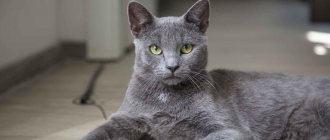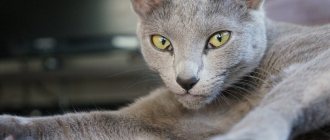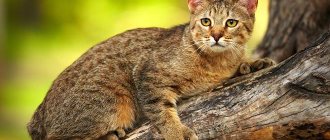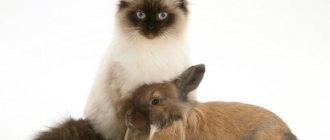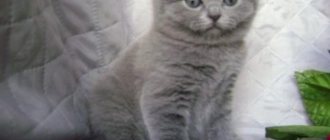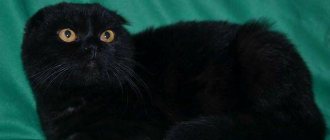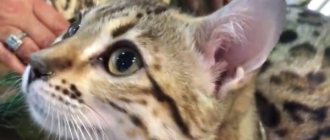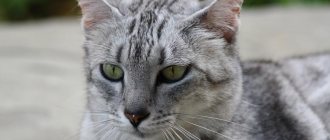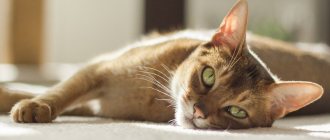A silver plush green-eyed archangel is what you get if you combine together the popular “names” of the Russian Blue cat breed. The soft and dense coat of these elegant beauties has a color that can only be described as blue with a silver tint.
She looks divine, especially when paired with exceptionally green eyes. But you shouldn’t look for wings in the description of the Russian blue cat; the British dubbed her “archangel” because of the homeland of her ancestors - the Arkhangelsk province.
From the history of the breed
There are two versions of how the first cats of this breed came from Russia to Great Britain. According to one, the mustachios were brought to the place by ordinary sailors, according to the second - by the ambassadors of Empress Catherine II as a present to the British crown.
In 1875, the Archangel Cat made its debut at the London Exhibition. The first breeder of the breed was an Englishwoman - Mrs. Constance Carew-Cox in 1893, personally brought three cats and a male from Arkhangelsk.
Mekong Bobtail
The Mekong Bobtail, formerly called the Thai Bobtail, was named after a river that flows through Southeast Asia.
Despite the fact that this breed of animals first appeared in Asian countries located along this river, the Mekong Bobtail breed began to develop only after it was imported to Russia. These pets are known for their playfulness, friendliness, sociability and curiosity.
Culture in the blood
Breeding the breed was an absolute pleasure, because its purebred representatives were distinguished by neatness and delicacy. The females did not scream even during the mating season, and the males did not mark corners.
Selection spoiled the character of the Russian Blue cat, and work on the mistakes affected the appearance - the skeleton became larger and the mass increased.
Note!
Snowshu: description and characteristics of the cat, care and maintenance- Munchkin: description and characteristics, care and maintenance of a short-legged cat
Thai cat: description and characteristics, care and maintenance, choosing a kitten
Wool is responsible for chic
This breed has no fundamental external differences from other brothers. The wide-set ears have rounded tips, and the upturned corners of the mouth make the cat appear to be smiling.
You won’t be able to appreciate the true chic of representatives of the Russian Blue cat breed in the photo, because their highlight is their fur. Dense and delicate thanks to the double structure, with a silvery tint to the bleached ends of the guard hairs, it feels like seal fur.
Don Sphynx
The Donskoy or Don Sphynx is one of the world's most popular hairless cat breeds in the world, similar to Sphynx cats (but the two breeds are not closely related). The Don Cat was discovered in 1986 or 1987 in the city of Rostov-on-Don by a woman named Elena Kovaleva, who rescued a kitten that was being tortured by a group of young boys.
When Kovaleva took the poor kitten, she discovered that he had become almost bald. She may have thought that the boys' mistreatment had led to the loss of most of their fur. Kovaleva decided to take the kitten home to treat it and help the kitten grow fur again. She named the kitten Varvara.
When Varvara later had her own kittens, some of her offspring were almost hairless. It is believed that Varvara's hairless kittens are the ancestors of the modern Don cat. It is believed that Donskoy's complete lack of hair was caused by a dominant genetic mutation.
Friendship must be earned
To stroke a beauty, you need to win her trust. These cats are as careful as they are smart. You don’t have to flirt and cajole your pets, just offer them friendship and give them a little time.
The reward for patience is an excellent companion who can easily adapt to the owner’s mood. He will become a participant in children's fun, tactfully listen to thoughts out loud, and keep company in front of the TV. He won’t follow you around, he won’t allow you to cuddle. But he will understand every word and gesture, and will give in if he persistently demands something.
The hunter doesn't sleep
Russian blue cats are desperate hunters. They have enough patience to wait until the prey makes the wrong move or gets tired of running away. If you deprive animals of the opportunity to hunt birds or insects, they will switch to things and household items.
Note!
Bengal cat: description, characteristics and maintenance of an exotic breedNorwegian Forest Cat - description of the breed, character, habits and maintenance of the Norwegian (110 photos and videos)
- Cat litter - detailed review, prices, how to choose, where to buy
They will look for the next “victim” by taking the highest position. Fortunately, the average weight of a Russian blue cat is up to 5, less often up to 7 kg, its average size and developed muscles allow it to acrobat for its own pleasure.
Peterbald
The descendants of the Don Sphynxes are considered to be the St. Petersburg Sphynxes - Peterbalds; when they were bred, crossings were carried out with oriental cats. Wool may be completely absent or some types may be present, including brush, velor, flock.
Peterbalds are smart animals with a good character, they are active and intelligent, and they love their owners very much. Such cats will never conflict with people, they will find an approach to other pets, and will be patient with the obsessive attention of children.
The average price of a pet is 15 thousand rubles.
Clean to the core
When these cats are not hunting, they spend their time grooming. They love shine, cleanliness and order in everything. Feeding should be on schedule, the tray should be without a hint of smell. It is not necessary to take your pets out into the fresh air, but you need to ventilate the house where they live at least once a week.
It’s good if the owners provide them with personal space - a house somewhere higher. And they won’t be too intrusive in grooming, because kitties do their own manicures, don’t need bath treatments (with the exception of getting ready for an exhibition) and don’t tolerate brushing.
Kurilian Bobtail
This is a rather interesting breed of cat, which was not specially bred. These animals have lived on Sakhalin Island and the Kamchatka Peninsula in Russia for more than 200 years. They have also been discovered in the Kuril archipelago, which connects Russia with Japan.
The Kurilian Bobtail looks like wild cats, but, surprisingly, this animal is very affectionate. However, given this cat's wild origins, it has a high energy level and a foraging instinct.
Let's do without milk
The issue of nutrition needs to be resolved with a veterinarian or breeder, since the coat may darken due to unsuitable food.
The basis of the diet is dairy and meat dishes, which must be combined for each feeding. Chicken, beef, sour cream, cottage cheese, kefir are suitable, fatty fish and milk are not, if the owner cares about the health of the pet.
Note!
Ragdoll - 110 photos, breed description, price, character and owner reviewsBritish shorthair cat - description of the contents, selection of food, personality traits and breed (105 photos)
Maine Coon: description of the breed, character, size, price and features of keeping a cat (110 photos + video)
Health is enviable
Purebred cats are in perfect health. Their origin is natural, and therefore the immunity is strong and there is no tendency to genetic diseases.
If you provide them with proper care and nutrition, they will be able to please the people they live with for an average of 15 to 25 years. Including, if we are talking about a cat, funny babies, of which there are unlikely to be more than three at a time.
Historical reference
Felinology, or the science of domestic cats, originated in England in 1871, when the world's first cat exhibition was held. In addition to showing pets, the organizers also set the first standards for several breeds.
The exhibition was held under the direction of an ordinary amateur - Harrison Ware. 16 years later, this man became the head of the British National Cat Club, which he independently founded and registered.
With his example, Harrison Ware inspired other cat lovers, so that soon more and more new organizations began to appear. In 1910 they became one, uniting to form the GCCF (Governing Council of the Cat Fancy).
Other countries also joined England. This led to the need to create the World Felinological Congress (WCC), which united the world's largest felinological organizations: WCF (Brazil, Germany, Belgium), TICA and CFA (USA), FiFe (Czech Republic) and the already familiar GCCF.
More expensive than all the shows
Before finding out how much a Russian Blue cat costs, the future owner must decide why he is getting one. The class depends on the purpose, and the price depends on the class.
The breeder will ask at least 5 thousand rubles for a pet-class kitten with a veterinary passport and the necessary vaccinations. You won’t go to an exhibition with this, but the breed will be visible.
If you also need a pedigree in order to start breeding yourself, you should pay attention to the breeding class and prepare at least 17 thousand rubles. Show-class babies will be the most expensive; 25 thousand rubles is the minimum. In general, they can ask for 35.
Neva Masquerade
This beautiful cat with bright blue eyes and long hair is the Siberian version. It is called Masquerade because the appearance of the Neva Masquerade, especially the eye part, is similar to a cat in a masquerade mask. The breed originated in 1989 thanks to the efforts of breeder Olga Mironova. The breed has a variety of colors, and the kittens themselves will be completely white for up to a month, regardless of their future coat color.
The cat has an excellent character - she is calm, playful and gets along well with all family members. Since she is a real purebred cat, she still has a sense of self-esteem, so she will not allow strangers to touch her.
